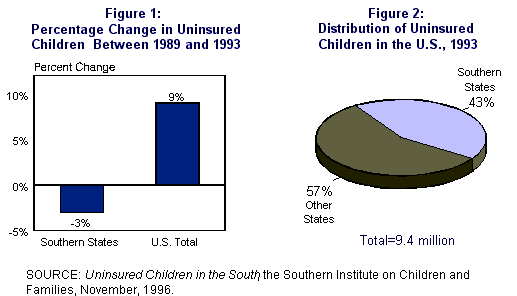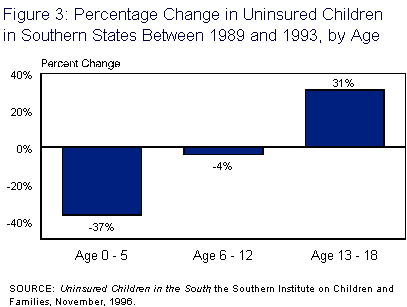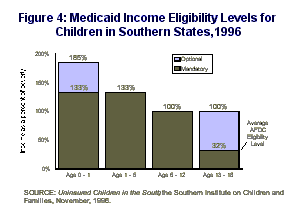The Debate About The Uninsured: How serious are their problems?
Embargoed for release until: 9:30 AM, EDT, Tuesday, October 22, 1996
For further information contact: Matt James or Tina Hoff
First National Study Asking People To Describe Health Care Experiences In Own Words: 46 Percent of Uninsured Adults Experienced “Serious” Consequences As a Result of Problems Getting and/or Paying for Health Care
Study Published in This Week’s JAMA
Washington, D.C. — Whenever health care is debated, one of the most hotly contested issues is the seriousness of the problem of the uninsured. A new study conducted by researchers at Harvard University, the Kaiser Family Foundation, and the National Opinion Research Center (NORC) at the University of Chicago finds that among adults who were uninsured at the time of the survey or over the course of the previous year a majority (53%) experienced some problem getting and/or paying for health care. This translates into approximately 20 million adults. The vast majority, or approximately 17 million adults nationwide, said they experienced “serious consequences,” in terms of their physical or mental health, family relationships, employment, and/or household finances, as a result of their problems getting and/or paying for health care. On the other hand, a significant percentage of uninsured adults — 47 percent — reported no problems either getting or paying for health care during the previous year.
Problems associated with getting and paying for health care were not limited to those without health insurance coverage. The survey found that among the insured adult population nearly one out of five (18 percent or 28 million adults) also faced such problems, with the majority, translating into 19 million adults, experiencing serious consequences.
Looking at the impact nationally, the survey suggests that overall nearly 50 million insured and uninsured adults had health care access or payment problems during the previous year, with 36 million experiencing serious consequences. The results of the survey are published in this week’s Journal of the American Medical Association (JAMA).
The survey of 3,993 randomly-sampled adults living in the United States was conducted between February and April 1995. It is the first national study to ask people to describe in their own words what, if any, problems they faced getting or paying for care and what consequences resulted. The survey finds that some 37 million adults were uninsured either at the time of the survey or at sometime during the previous year.
“This study demonstrates that there are real consequences of being without health insurance for tens of millions of Americans each year. The biggest challenge ahead is to figure out how to address this problem and how to pay for it,” said Drew E. Altman, Ph.D., President, Kaiser Family Foundation.
The Uninsured
The uninsured were four times more likely to report an episode of needing but not getting medical care, and three times more likely to report a problem paying health care bills than adults with insurance. The sickest people surveyed were those most likely to report problems: among the uninsured in the poorest health, three out of four (75%) adults reported problems getting care and 67 percent said they had problems paying for care.
“Most strikingly, the sickest people surveyed are most likely to have problems getting the medical care they need. The vast majority of uninsured adults in poor health had difficulty getting care. This finding directly contradicts the conventional wisdom that truly sick people can always get care when they need it,” said Karen Donelan, Sc.D., Harvard University, the study’s principal author.
53 Percent of Uninsured Adults Reported Problems Getting and/or Paying for Health Care During the Previous Year, With Approximately 17 Million of These Adults Nationwide Experiencing Serious Consequences.
- 28 percent of uninsured adults experienced problems both getting and paying bills, with 90 percent of this group (10 million adults) rating the consequences of these problems as “serious” in terms of their physical and mental health, family relationships, employment, and household finances;
- Another 17 percent of uninsured adults experienced problems getting care only, with 79 percent of this group (5 million adults) rating the consequences of their access problem as “serious.” Randomly-selected responses about medical conditions regarded as “serious” included “rapid heart rate,” “hypertension,” “coughing, tight breathing,” and “angina;”
- 8 percent of uninsured adults experienced problems paying bills only, with 67 percent (2 million adults) rating the consequence of their payment problem as “serious;” and
- 47 percent of the uninsured reported no problems either getting or paying for health care.
Among the uninsured who faced problems paying health care bills (36% of all uninsured adults), 49 percent said they paid more than $1,000 out-of-pocket, and 8 percent, more than $5,000. Two-thirds (63%) still owed money for these bills at the time they were surveyed, with seven out of ten owing more than $1,000; 22 percent, $1,000-$5,000; and 2 percent, $20,000 or more. More than four out of ten (44%) of the uninsured who reported payment problems had been contacted by a collection agency. Only a third (37%) received medical care for free or for a reduced charge in the previous year.
“From a human interest perspective, it’s worth noting that among uninsured adults who have problems paying medical bills, more report they were referred to a collection agency than say they got medical care for free or a reduced charge,” said Robert J. Blendon, Sc.D., Harvard University, a member of the study team.
The survey also found that very few Americans are uninsured by choice: fewer than one out of ten adults said they did not want or need health insurance or just did not think about getting it. The cost of health care coverage was the principal reason they said they did not have insurance.
The Under-Insured
Among the Much Larger Population with Insurance, 18 percent of Adults Reported Problems Getting and/or Paying for Health Care During the Previous Year.
- 4 percent of insured adults reported problems both with getting health care and paying bills, with 86 percent (5 million adults) rating these problems as serious;
- Another 7 percent of insured adults reported problems getting health care only, with 62 percent (6 million adults) rating these problems as serious;
- 7 percent of insured adults reported problems paying bills only, with 75 percent (8 million adults) rating these problems as serious; and
- 81 percent of insured adults reported no problems either getting or paying for health care.
Randomly-Selected Verbatim Accounts About the Consequences of Problems Getting and/or Paying for Health Care
Respondents Who Said Their Consequences Were “Very Serious” or “Somewhat Serious”
The Uninsured
Problems getting care (female, age 38): “Related to the MS [multiple sclerosis] that I have. I need a specific medicine that lessens the exacerbations of the disease and I can’t afford to get it. Its very frustrating and makes me angry because I’m progressing in my disease without the medicine that could possibly slow it up.”
Problems paying medical bills (female, age 31): “My two daughters have a problem with eyesight and I don’t have the money to go to the eye doctor, and my children have a toothache and I don’t have the money to take them to the dentist. If I pay the doctor, I don’t have the money to pay the rent and I won’t have a roof and its important to get food.”
Both problems (female, age 45): “I needed surgery for cataracts but my doctor couldn’t do the surgery because I didn’t have insurance. The doctor said I had cancer… they gave me a hysterectomy because I had cancer. [Program name] paid almost all of the bill and I paid off the rest in payments. I was unemployed for 6 months. It was hard to meet all the payments of the other bills.”
The Insured
Problems getting care (male, age 36): “Family history of colon cancer, was advised to get a screening every 2 years. It affects my finances because we have not met the deductible. We have a $2,500 deductible. I guess that the only gripe I have is that I pay too much for insurance and they’re raising it again by $100 a month.”
Problems paying medical bills (female, age 67): “I have to pay out of a Social Security check of $362 a month for [insurance company’s name]. They want $500 per month. Something wrong. Medicare doesn’t pay the full cost of hospital or medicine. I don’t take prescriptions then–it costs $100. Other people get food stamps, whatever they want. I was born here, worked here, get nothing.”
Both problems (female, age 46): “One medical problem I do have is depression. [I’m supposed to go to] the doctor every 3 months. Can’t afford it. You get very stressful. It makes the problem worse and you just don’t go… It would be nice to go to the doctor to get antibiotics and not have to worry about bills.”
Methodology
The survey was designed by the Harvard School of Public Health, the Kaiser Family Foundation, and the National Opinion Research Center (NORC). The nationwide survey was conducted by telephone during the period of February 22-April 27, 1995. 3,993 adults were interviewed. 1,234 adults (31% of respondents) had at least one of three key events during the previous year: an episode of being uninsured, a problem getting medical care they thought they needed, or a problem paying medical bills. After answering detailed questions about these events, respondents were asked to tell in their own words about the consequences of those events on physical or mental health, family relationships, employment, or household finances and to rate how severe these consequences were for them. The margin of sampling error for a sample of 3,993 adults is approximately plus or minus 1%, and increases for smaller subgroups of the sample (e.g. a maximum of plus or minus 3% for 1,234 adults, plus or minus 4% for 600 adults, and plus or minus 10% for 100 adults).
The Kaiser Family Foundation, based in Menlo Park, California, is a non


